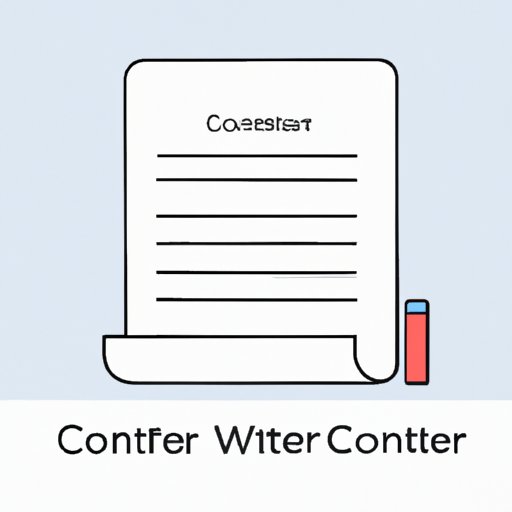Introduction
Writing a whitepaper can be a daunting task. It requires a lot of research and knowledge of the topic, as well as an understanding of how to craft persuasive arguments. To make matters worse, it also needs to be written in a clear and concise manner that will engage readers and draw them into your argument. But don’t panic! This guide will provide you with all the information you need to write a successful whitepaper.

Defining Whitepaper Writing: What is it and How to Write One
A whitepaper is a document that provides an in-depth explanation of a specific topic or issue. It is typically longer than other types of documents and presents a comprehensive overview of the subject matter. Whitepapers are often used by organizations and companies to explain their products and services in detail, but they can also be used to discuss the latest trends in a particular industry, or to educate readers about a certain topic.
When writing a whitepaper, it is important to keep in mind that it should be structured like an essay. It should have an introduction, a body, and a conclusion. The introduction should introduce the topic and provide some background information. The body should provide an in-depth discussion of the subject matter, while the conclusion should summarize the main points and provide a call to action.

Overview of the Purpose and Benefits of Writing Whitepapers
Writing whitepapers can be beneficial to both businesses and individuals. For businesses, whitepapers can be used to educate potential customers about their products or services, or to establish themselves as experts in their field. They can also be used to generate leads and drive sales. For individuals, whitepapers can be used to demonstrate their expertise and attract potential employers.
In addition to being a useful marketing tool, whitepapers can also be used to promote thought leadership. By presenting thoughtful and detailed arguments on a given topic, writers can position themselves as authorities on the subject. This can help to build credibility and trust among readers, which can lead to more opportunities.

A Guide to Creating a Compelling Whitepaper
Now that you understand the purpose of a whitepaper, let’s look at how to create one. The first step is to develop an effective outline. This will serve as the roadmap for your paper and ensure that you stay on track as you write.
Crafting a Winning Whitepaper Outline
When developing your outline, start by deciding what your main point or argument will be. Then, determine how you will support this point with evidence or examples. Once you have your main point and supporting evidence, you can begin to structure your outline. Start by dividing your paper into sections and subsections, and then decide what topics you will cover in each section. Remember to use headings and subheadings to clearly organize and present your ideas.
Developing Content for Your Whitepaper
Once you have your outline in place, it’s time to start writing your whitepaper. Begin by researching your topic and gathering relevant information. Make sure to include sources where appropriate, and cite them using the correct format. As you write, remember to focus on clarity and conciseness. Avoid long-winded sentences and try to get to the point quickly. Also, avoid jargon and technical terms unless absolutely necessary.
Tips and Strategies for Writing an Effective Whitepaper
Now that you know the basics of writing a whitepaper, here are some tips to help you create an effective document:
Researching Your Topic
Before you start writing, make sure to do your research. Gather as much information as possible and read up on the latest developments in the field. This will ensure that your arguments are well-informed and up-to-date.
Using Clear and Concise Language
As mentioned before, it’s important to use clear and concise language when writing a whitepaper. Avoid using overly complicated words and phrases, and focus instead on getting your point across quickly and effectively.
Emphasizing Your Points with Examples
Include examples and case studies to illustrate your points. This will help readers to better understand your arguments and will make your whitepaper more engaging.

Editing and Refining Your Whitepaper for Maximum Impact
Once you’ve finished writing your whitepaper, it’s time to edit and refine it for maximum impact. Start by proofreading your document for any grammar or spelling errors. If possible, have someone else review your work to catch any mistakes you might have missed. Next, consider formatting and design considerations. Pay attention to details such as font size, line spacing, and page layout. Finally, review your paper to make sure it flows logically and that your arguments are well-supported.
Conclusion
Writing a whitepaper can be a challenge, but the rewards are worth it. With the right approach, you can create a compelling document that will help to establish you as an authority in your field. Follow the steps outlined in this guide and you’ll be well on your way to crafting an effective whitepaper.
Whitepapers can be an incredibly powerful tool for businesses and individuals alike. They can be used to educate potential customers, promote thought leadership, and even generate leads. By following the steps outlined in this guide, you can create a compelling whitepaper that will help you achieve your goals.
(Note: Is this article not meeting your expectations? Do you have knowledge or insights to share? Unlock new opportunities and expand your reach by joining our authors team. Click Registration to join us and share your expertise with our readers.)
